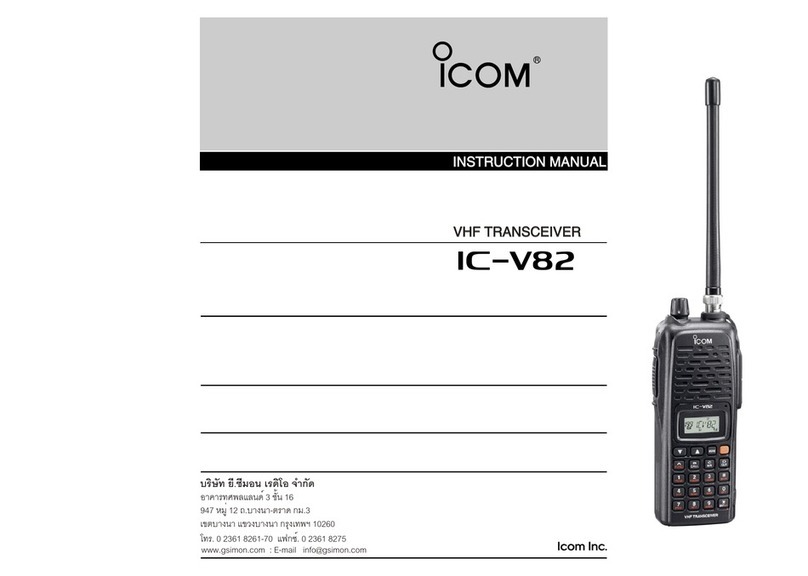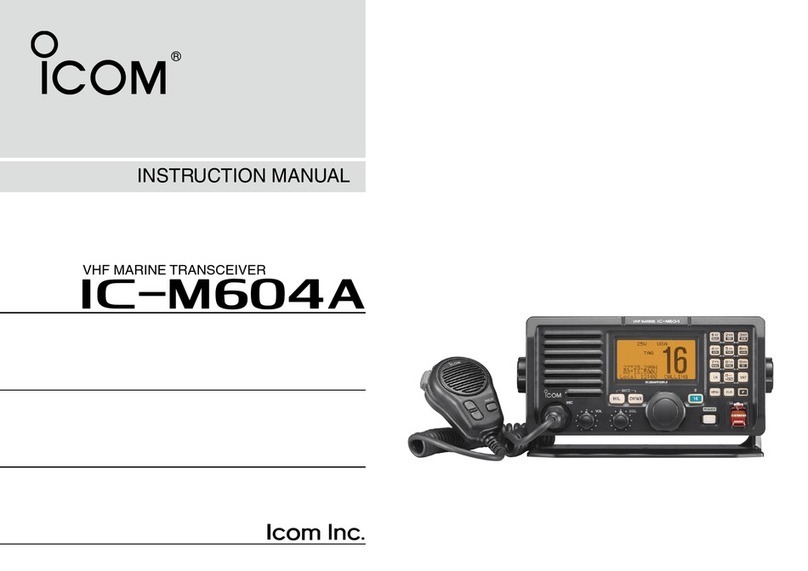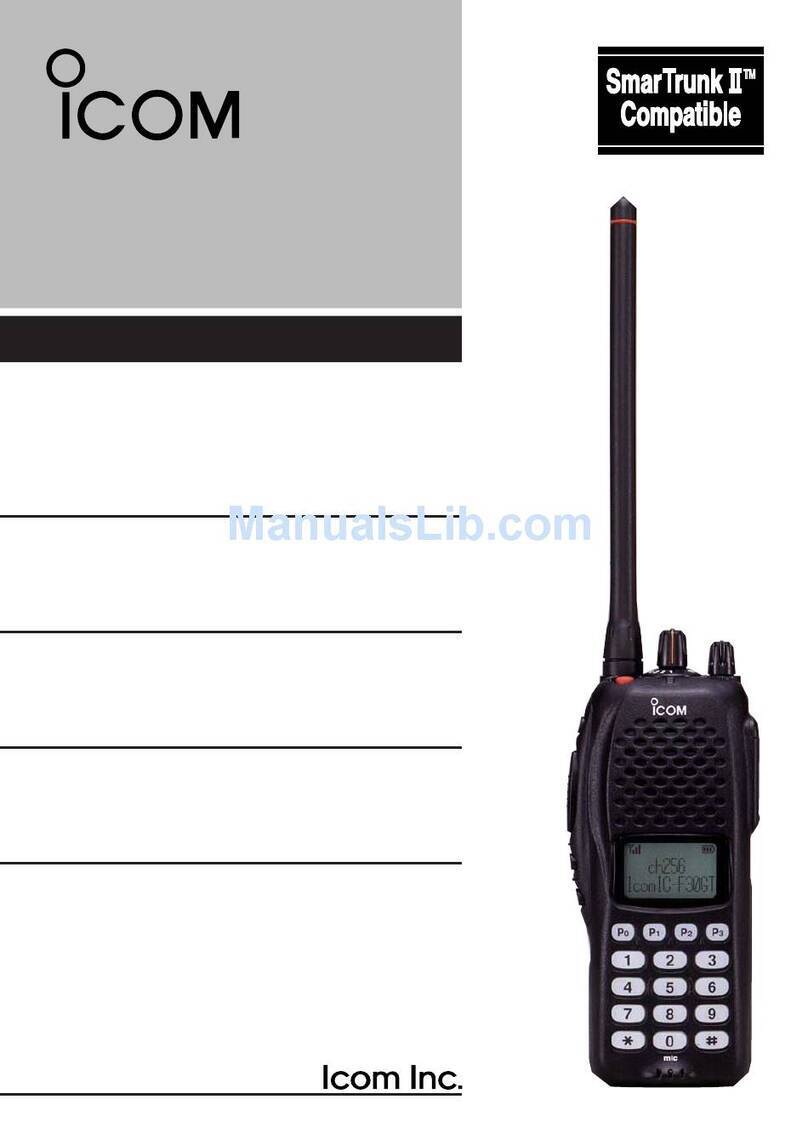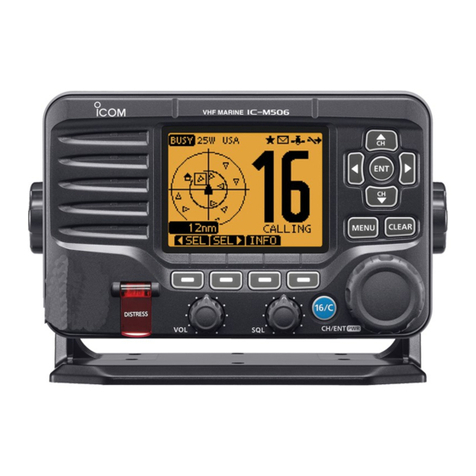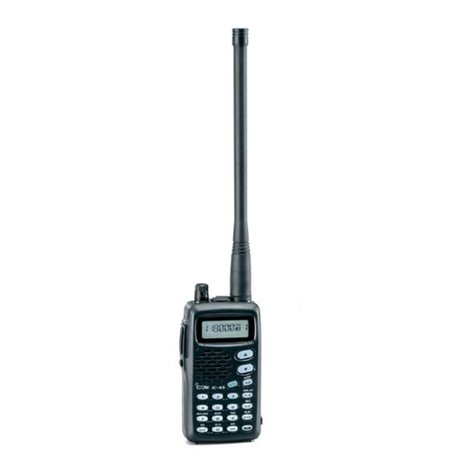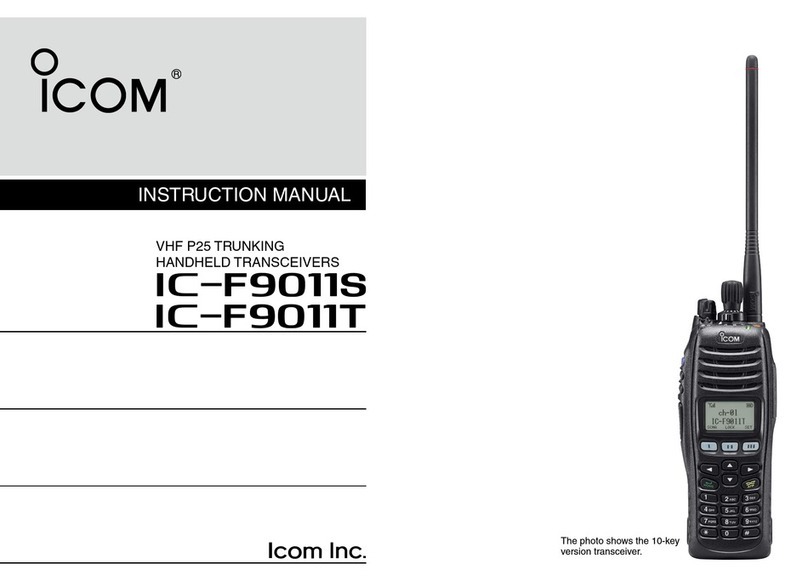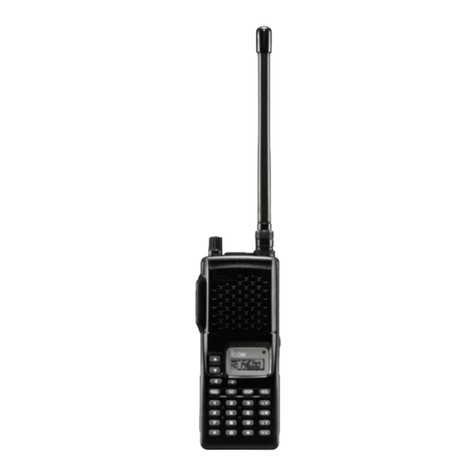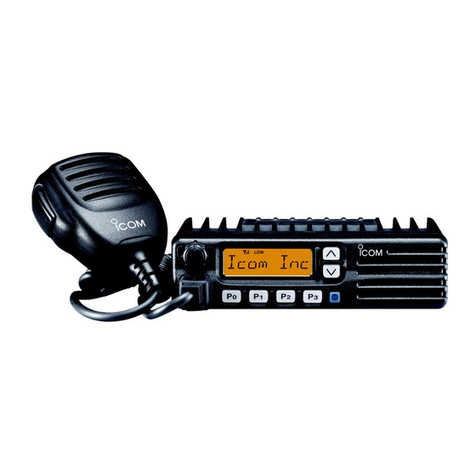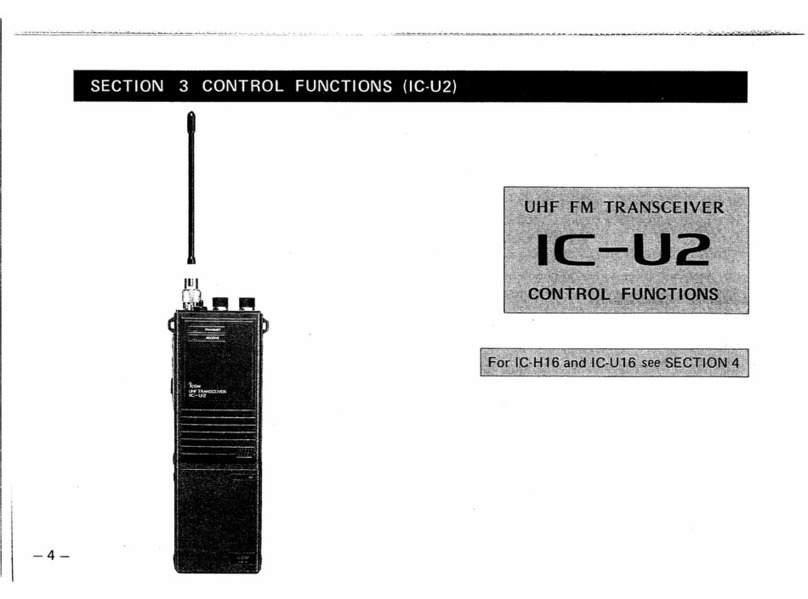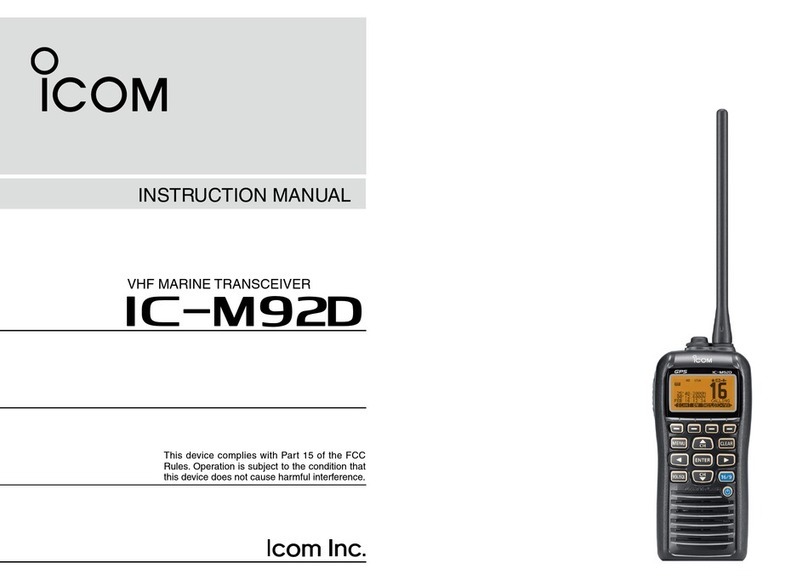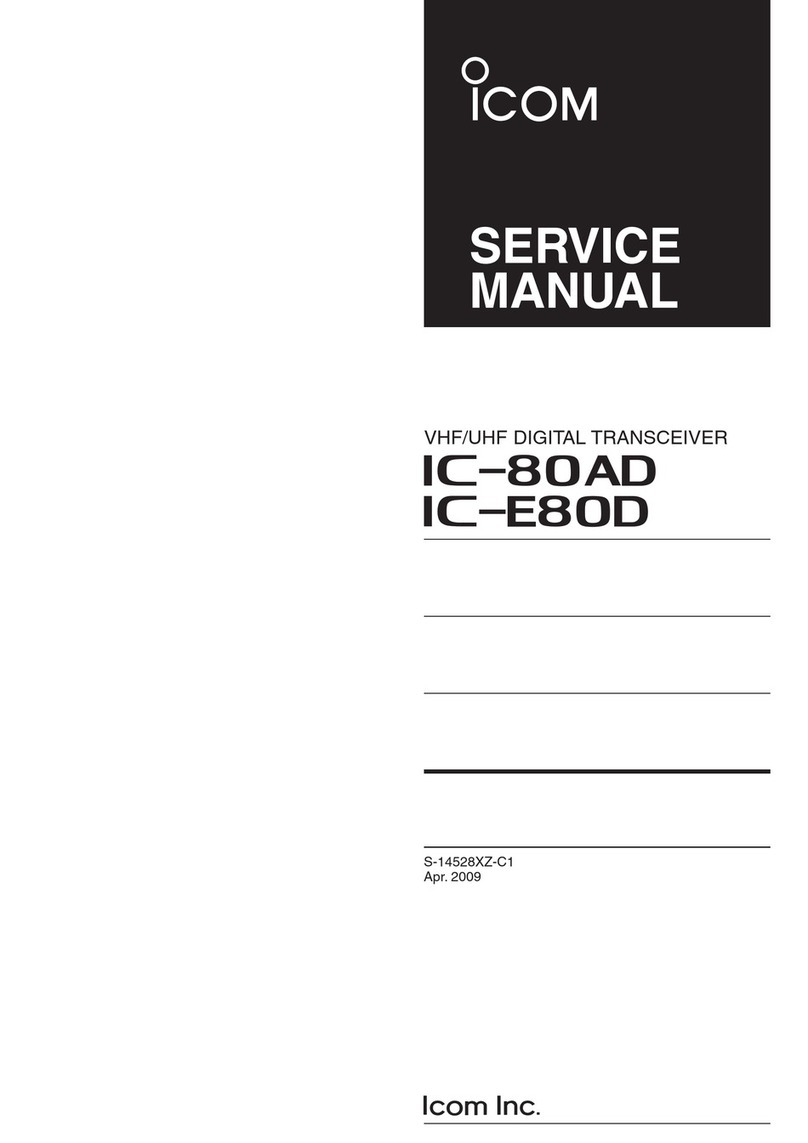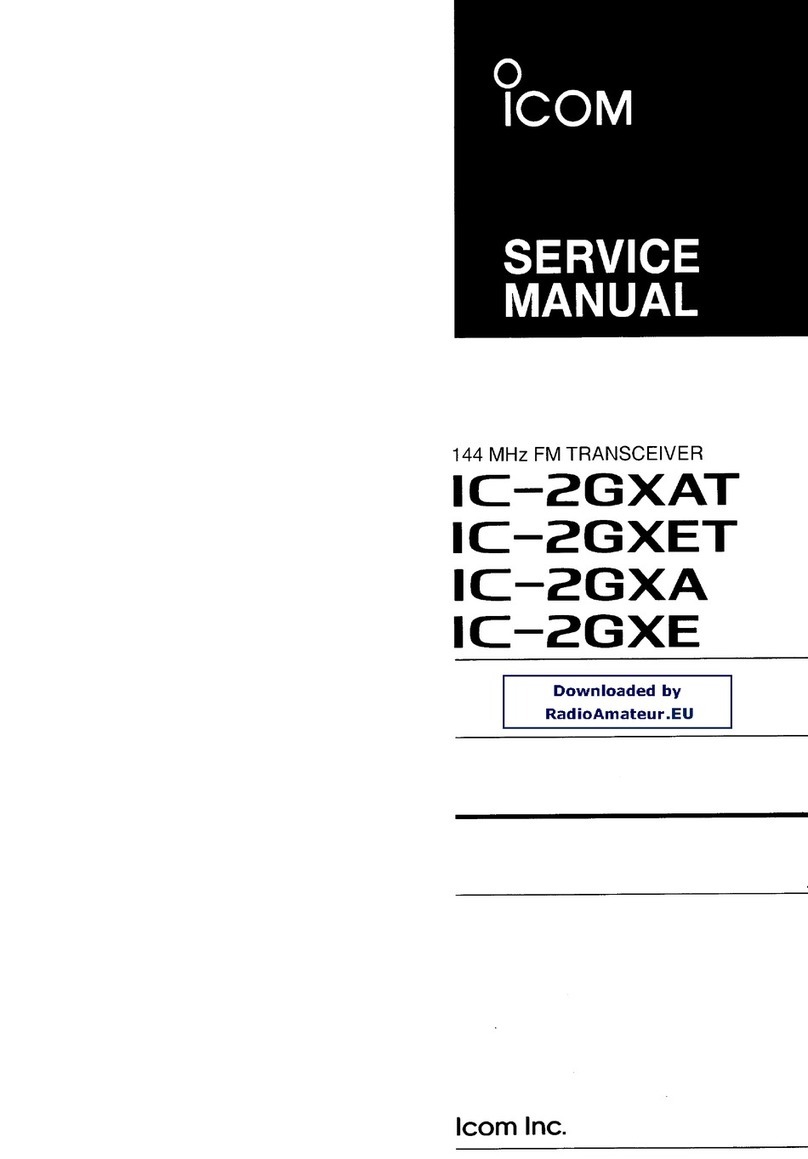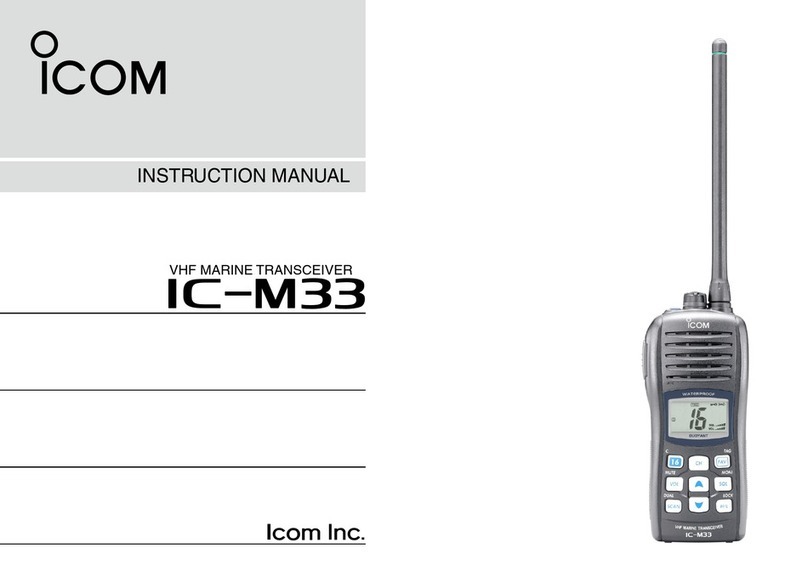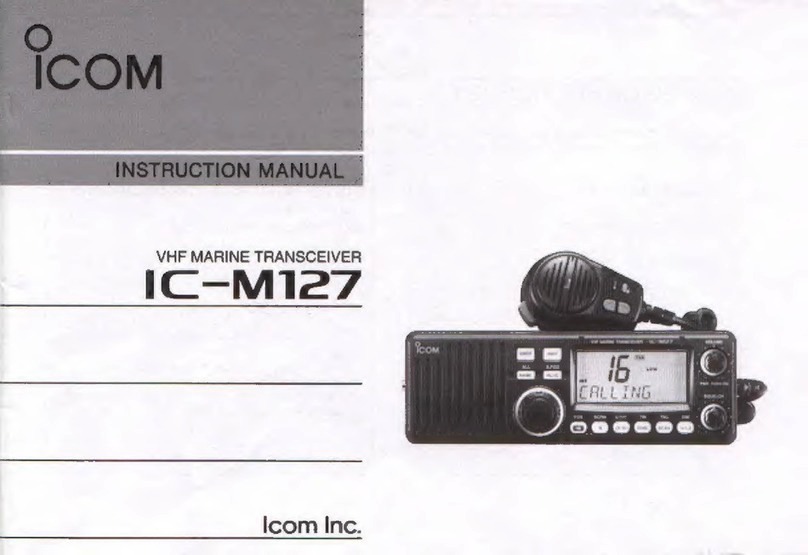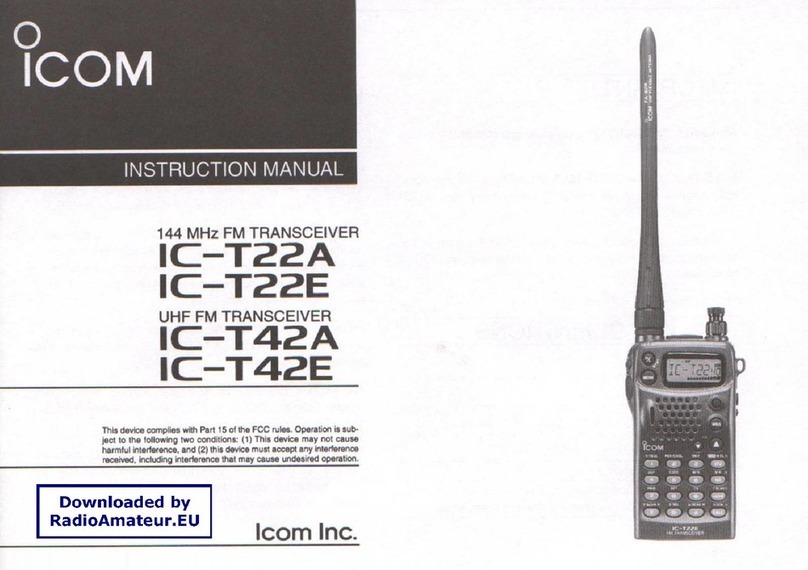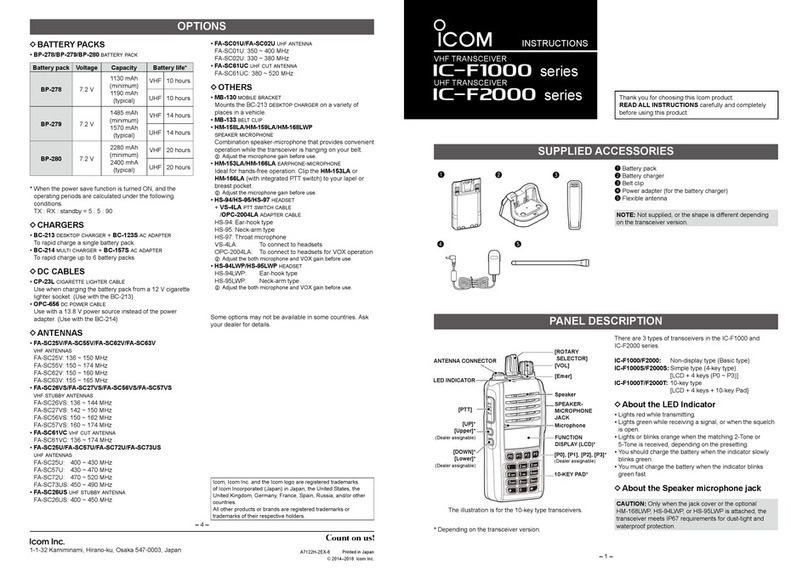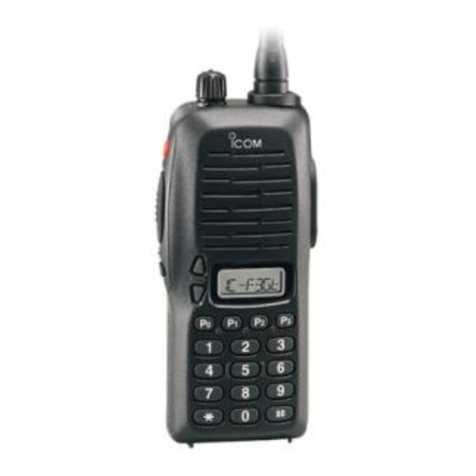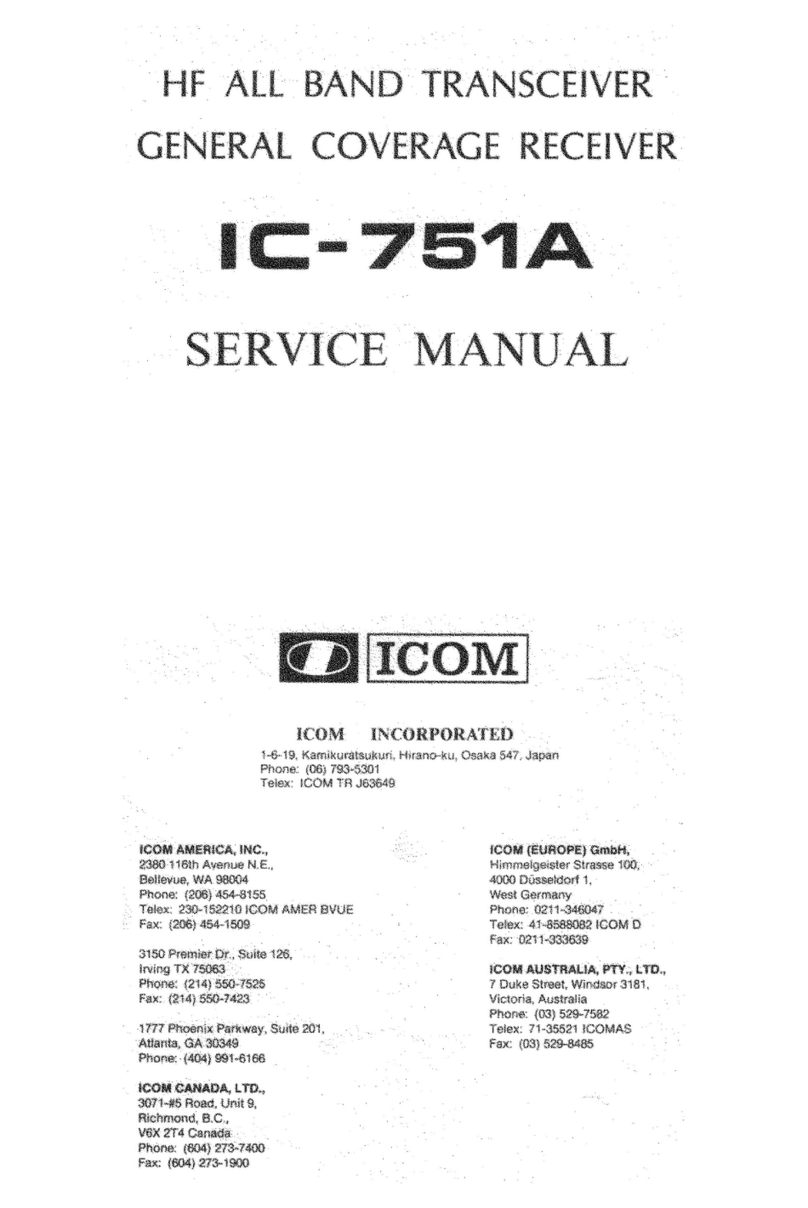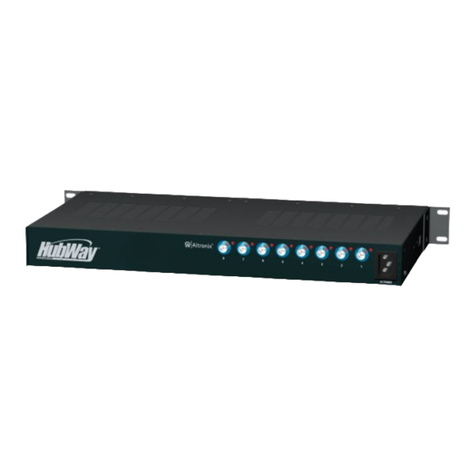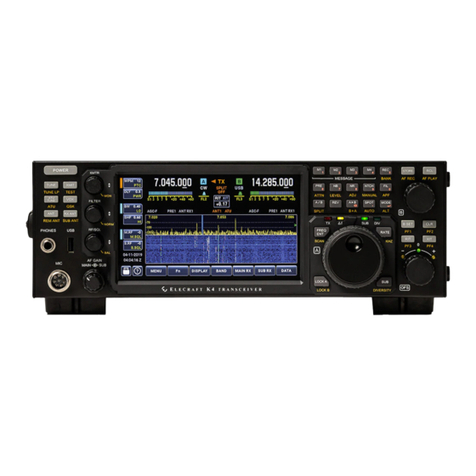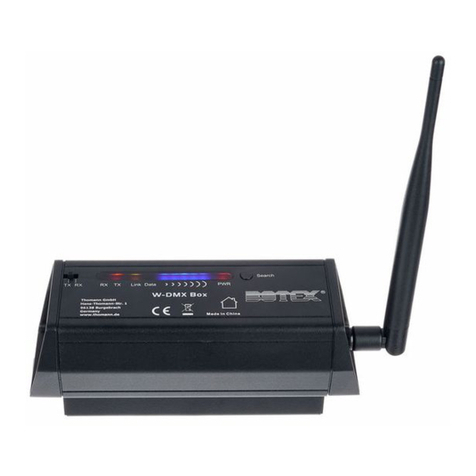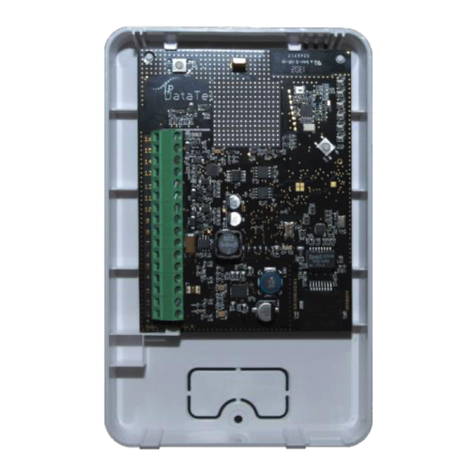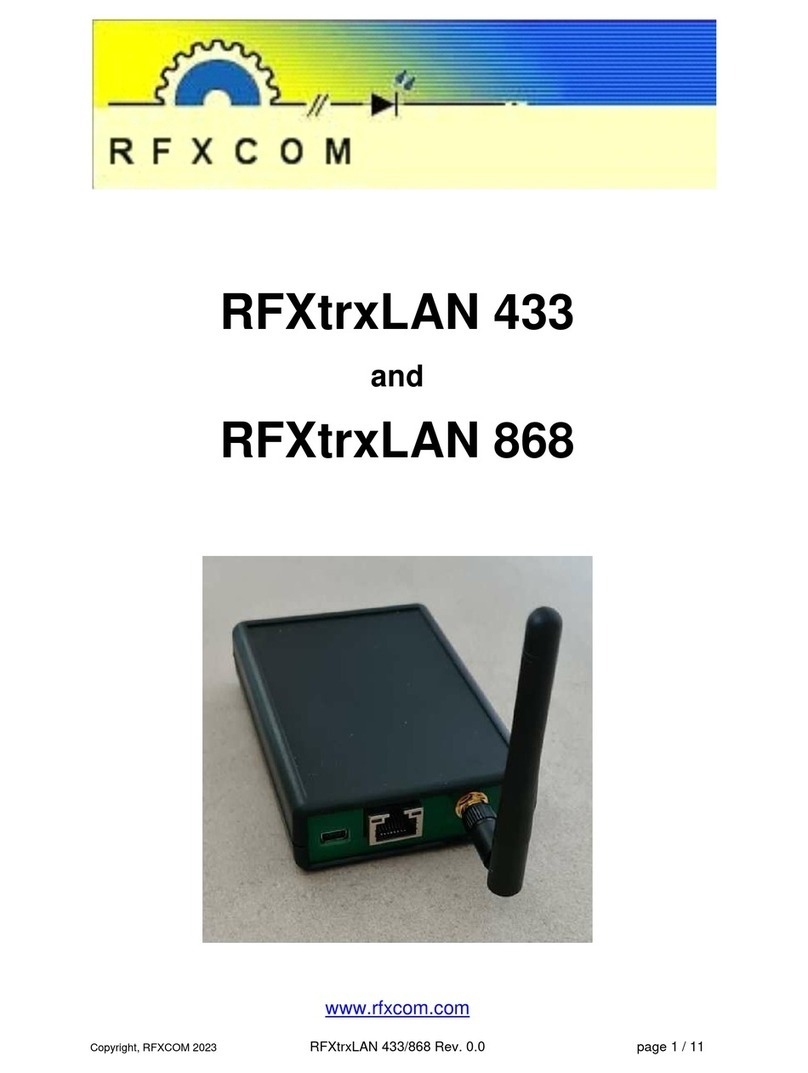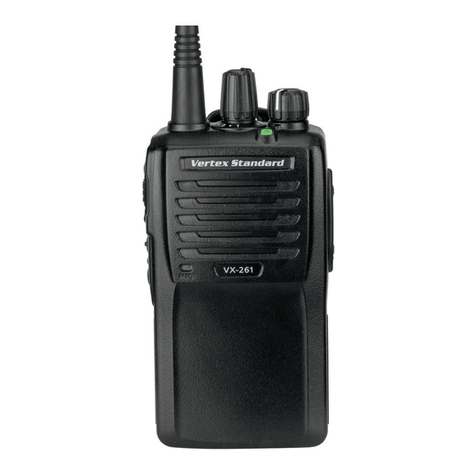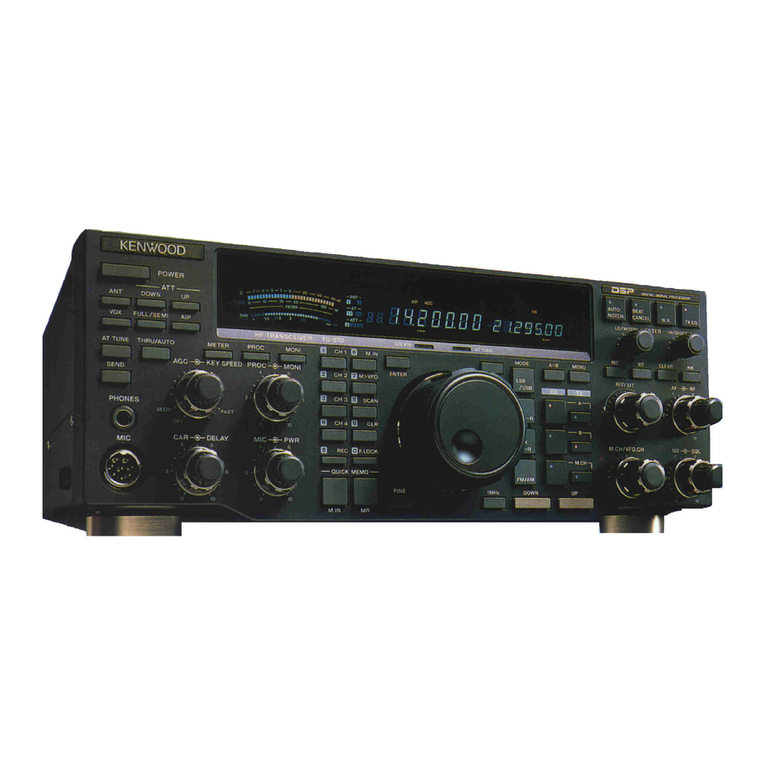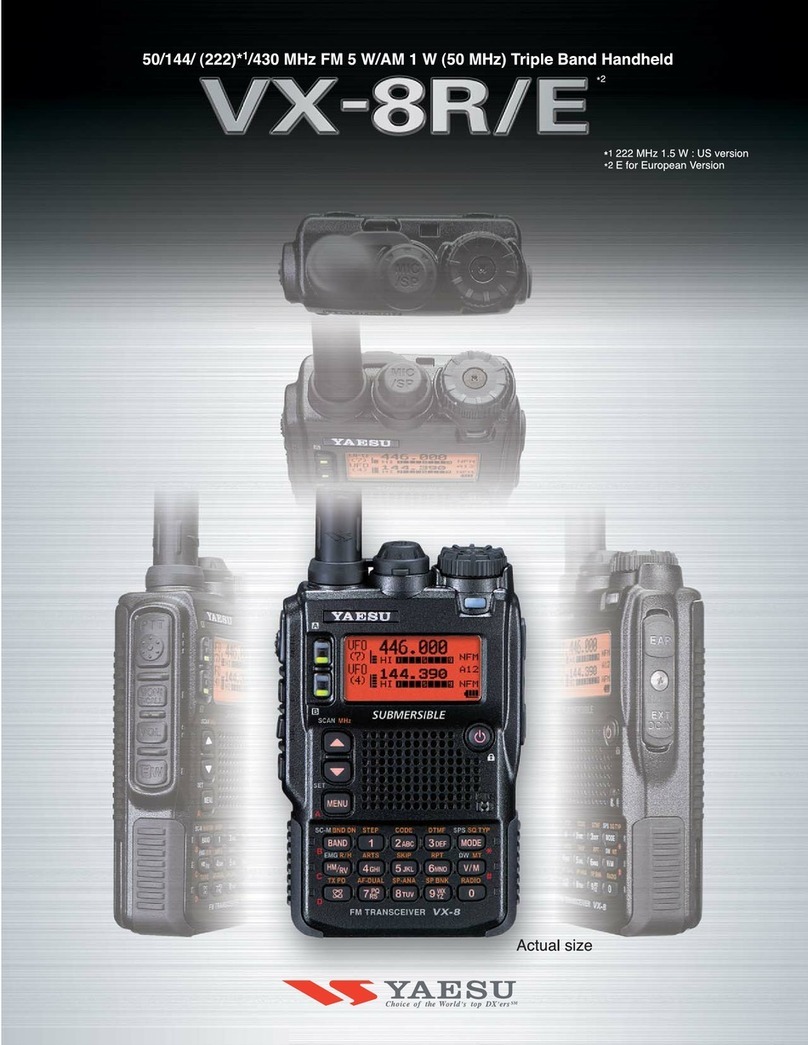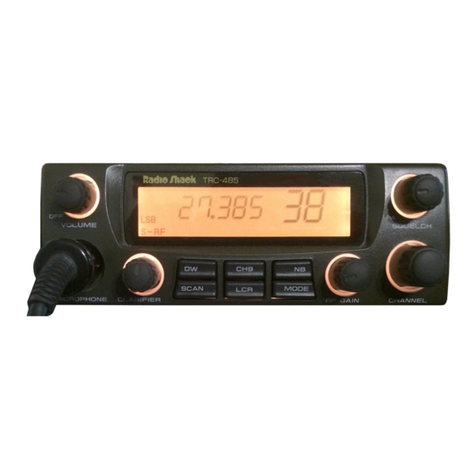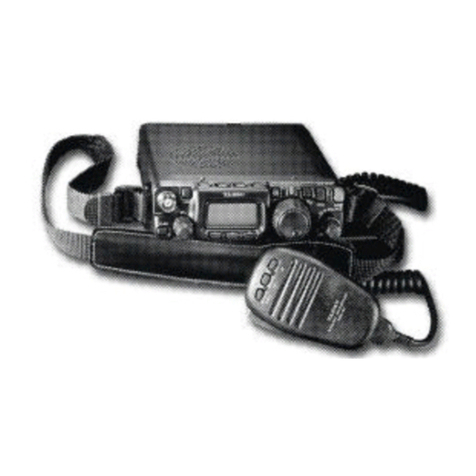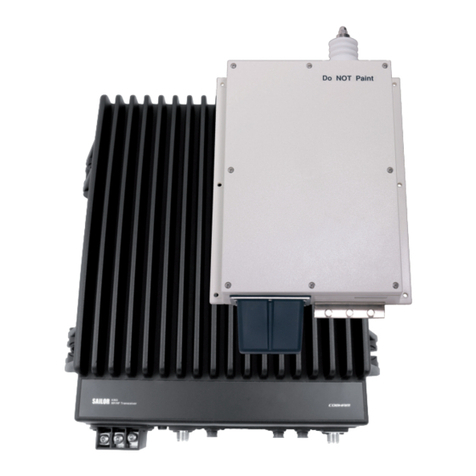Icom IC-F521 User manual

INSTRUCTION MANUAL
iF621
UHF TRANSCEIVER
iF521
VHF TRANSCEIVER

i
RWARNING! NEVER connect the transceiver to an
AC outlet. This may pose a fire hazard or result in an electric
shock.
RWARNING! NEVER connect the transceiver to a
power source of more than 16 V DC such as a 24 V battery.
This connection will ruin the transceiver.
RWARNING! NEVER cut the DC power cable be-
tween the DC plug and fuse holder. If an incorrect connec-
tion is made after cutting, the transceiver might be damaged.
RWARNING! NEVER place the transceiver where
normal operation of the vehicle may be hindered or where it
could cause bodily injury.
CAUTION! NEVER allow children to touch the trans-
ceiver.
CAUTION! NEVER expose the transceiver to rain,
snow or any liquids.
USE supplied or optional microphone only. Other micro-
phones have different pin assignments and may damage the
transceiver.
DO NOT use or place the transceiver in areas with tem-
peratures below –22°F (–30°C) or above +140°F (+60°C), or
in areas subject to direct sunlight, such as the dashboard.
PRECAUTIONS
IMPORTANT
READ ALL INSTRUCTIONS carefully and com-
pletely before using the transceiver.
SAVE THIS INSTRUCTION MANUAL — This
instruction manual contains important operating instructions for
the IC-F521 VHF TRANSCEIVER and IC-F621 UHF TRANS-
CEIVER.
EXPLICIT DEFINITIONS
WORD DEFINITION
RWARNING Personal injury, fire hazard or electric
shock may occur.
CAUTION Equipment damage may occur.
NOTE
If disregarded, inconvenience only. No risk
of personal injury, fire or electric shock.
Icom, Icom Inc. and the logo are registered trademarks of
Icom Incorporated (Japan) in the United States, the United King-
dom, Germany, France, Spain, Russia and/or other countries.

PRECAUTIONS
DO NOT operate the transceiver without running the vehi-
cle’s engine. The vehicle’s battery will quickly run out when
the transceiver transmits while the vehicle’s engine is OFF.
DO NOT place the transceiver in excessively dusty envi-
ronments.
DO NOT place the transceiver against walls. This will ob-
struct heat dissipation.
DO NOT use chemical agents such as benzine or alcohol
when cleaning, as they damage the transceiver surfaces.
BE CAREFUL! The transceiver will become hot when
operating continuously for long periods.
Icom optional equipment is designed for optimal perform-
ance when used with this transceiver. We are not respon-
sible for the transceiver being damaged or any accident
caused when using non-Icom optional equipment.
For U.S.A. only
CAUTION: Changes or modifications to this transceiver, not
expressly approved by Icom Inc., could void your authority to
operate this transceiver under FCC regulations.
TABLE OF CONTENTS
ii
IMPORTANT .......................................................................... i
EXPLICIT DEFINITIONS....................................................... i
PRECAUTIONS..................................................................... i
TABLE OF CONTENTS........................................................ ii
1 PANEL DESCRIPTION................................................1–6
■ Front panel ...................................................................1
■Function display ...........................................................2
■Programmable function keys........................................3
2 OPERATION ..............................................................7–10
■Turning power ON ........................................................7
■ Channel selection.........................................................7
■Receiving and transmitting...........................................8
3 CONNECTION AND MAINTENANCE ....................11–16
■Rear panel and connection ........................................11
■Supplied Accessories.................................................12
■Mounting the transceiver ............................................13
■ Optional UT-108 installation .......................................15
■ Optional UT-109/UT-110 installation...........................15
■ Optional OPC-617 installation....................................16
■ Antenna......................................................................16
■ Fuse replacement ......................................................16
■ Cleaning .....................................................................16
4 OPTIONS.......................................................................17
5 SAFETY TRAINING INFORMATION.............................18
6 FCC INFORMATION......................................................19

■Front panel
r
ew
q
u y t
qAF VOLUME CONTROL KNOB
➥Rotate the knob to adjust the audio output level.
• Minimum audio level is pre-programmed.
wLEFT UP/DOWN [∫]/[√] KEYS
➥One of several functions can be programmed by your
Dealer. (Same as [P0] to [P4] keys)
eFUNCTION DISPLAY
➥Displays variety of information, such as an operating
channel number/name, 2/5tone code, DTMF numbers and
audible condition, etc.
NOTE: The above functions depend on pre-programming.
rRIGHT UP/DOWN [ ]/[ ] KEYS
➥Push to select the operating channel.
➥Can be programmed for one of several functions by your
Dealer. (Same as [P0] to [P4] keys)
1
1PANEL DESCRIPTION

tDEALER-PROGRAMMABLE KEYS [P0] to [P4]
➥Desired functions can be programmed independently by
your Dealer.
yPOWER SWITCH [POWER]
➥Push and hold to turns the power ON and OFF.
• The following functions are available at power ON as options:
- Automatic scan start
- Password prompt
- Set mode
uMICROPHONE CONNECTOR
➥Connect the supplied or optional microphone.
NEVER connect non-specified microphones. The pin
assignments may be different and the transceiver may be
damaged.
MICROPHONE
➥The supplied or optional microphone has a PTT switch
and a hanger hook.
• The following functions are available when the microphone is on
or off hook:
- Automatic scan start when hung on.
- Automatic priority channel selection when hung off.
- Sets to ‘Inaudible’ condition (mute condition) when hung on.
- Sets to ‘Audible’ condition (un-mute condition) when hung off.
■Function display
q w e r t y u i
o
qTRANSMIT INDICATOR
➥Appears while transmitting or sending a 2/5tone code.
wBUSY INDICATOR
➥Appears while the channel is in busy.
eSIGNAL STRENGTH METER
➥Indicates relative signal strength level.
rLOW POWER INDICATOR
➥Appears when low output power is selected.
tAUDIBLE INDICATOR
➥Appears when the channel is in the ‘Audible’ condition
(unmute condition).
yCOMPANDER INDICATOR
➥Appears when compander function is activated.
2
1
PANEL DESCRIPTION

uSCRAMBLER INDICATOR
➥Appears when scrambler function is activated. (Optional
UT-109 (#02)/UT110 (#02) SCRAMBLER UNIT is
required.)
i2/5TONE INDICATOR
➥Appears when specified 2/5tone call is received.
oALPHANUMERIC DISPLAY
➥Displays the CH number, 2/5tone indication, DTMF
numbers, Audible indication, etc.
■Programmable function keys
The following functions can be assigned to [P0], [P1], [P2],
[P3], [P4], [∫], [√], [ ] and [ ] programmable function
keys.
Consult your Icom Dealer or System operator for details con-
cerning your transceivers programming.
In the following explanations, programmable function names
are bracketed, the specific switch used to activate the func-
tion depends on programming.
CH UP AND DOWN KEYS
• Select an operating channel.
• Select a transmit code channel after pushing
the [
TX CH
] key.
• Select a DTMF channel after pushing the
[
DTMF
] key.
• Select a scan group while pushing and holding
the [
SCAN
] key.
OPERATING CHANNEL KEYS
Select an operating channel directly.
PRIORITY CHANNEL KEYS
Select priority A or priority B channel with each
push.
[CH UP]
[CH DN]
[CH1]
[CH2]
[CH3]
[CH4]
[PRI A]
[PRI B]
3
1PANEL DESCRIPTION

MONITOR KEY
Activates one of (or two of) the following func-
tions on each channel independently:
• Push and hold the key to unmute the channel (audio
is emitted; ‘Audible’ condition).
• Push the key to toggle the mute and unmute condi-
tions (toggles ‘Audible’ and ‘Inaudible’).
• Push the key to mute the channel (sets to ‘Inaudible’
only).
• Push the key to unmute the channel (sets to ‘Audible’
only).
• Push the key after the communication is finished to
send a ‘reset code’.
NOTE: The unmute condition (‘Audible’ condi-
tion) may automatically return to the mute
condition (‘Inaudible‘ condition) after a speci-
fied period.
WIDE/NARROW KEY
Push [W/N] to toggle bandwidth between wide
or narrow.
OUTPUT POWER SELECTION KEYS
Select the transmit output power temporarily or
permanently depending on the pre-setting.
• Ask your Dealer or System Operator for the
output power level for each selection.
[MONI]
[W/N]
[H/L]
BANK KEY
Select and determine a bank number.
• Push [BANK] then push [CH UP]/[CH DN] to
select operating bank number, and then push
[BANK] to determine the bank number.
SCAN START/STOP KEY
Push this key to start scanning; and push again
to stop.
NOTE: Place the microphone on hook to
start scanning.
Take the microphone off hook to stop scan-
ning.
Push and hold this key to indicate the scan
group, then push to select the desired group.
SCAN TAG KEY
Adds or deletes the selected channel to the
scan group.
LOCK KEY
Electronically locks all programmable keys ex-
cept the following:
•[
CALL
](incl. [CAL A] and [CAL B]), [
MONI
]and
[
EMER
]keys.
[BANK]
[SCAN A]
[SCAN B]
[TAG]
[LOCK]
4
1
PANEL DESCRIPTION

TALK AROUND KEY
Turns the talk around function ON and OFF.
• The talk around function equalises the transmit
frequency to the receive frequency for mobile-
to-mobile communication.
CALL KEYS
Transmit a 2-tone code.
• Call transmission is necessary before you call
another station depending on your signaling
system.
EMERGENCY KEY
Push and hold the key to transmit an emergency
call.
• If you want to cancel the emergency call, push
(or push and hold) the key again before trans-
mitting the call.
• The emergency call is transmitted one time
only or repeatedly until receiving a control code
depending on the pre-setting.
[ T A ]
[CALL]
[EMER]
TX CODE CHANNEL UP/DOWN KEY
Push to selects a TX code channel directory.
DTMF CHANNEL SELECT KEY
Push this key to select a DTMF channel.
• Push this key, then select the desired DTMF
channel using the [ ]/[ ] keys.
Push the key to transmit the selected DTMF
code.
C. TONE CHANNEL ENTER KEY
Push this key then input a continuous tone
memory channel number using [ ]/[ ] keys
to change the tone frequency.
[CODE]
[DTMF]
[TONE]
5
1PANEL DESCRIPTION

ID MEMORY READ KEY
Recalls detected ID codes.
• Push this key, then push [ ]/[ ] for selec-
tion.
• Up to 5 ID
’
s are memorized.
Push and hold this key to erase all memorized
IDs.
TRUNKING GROUP KEY
Push to select the Trunking group.
MIC COMPANDER KEY
Push to toggle the mic compander function ON
or OFF.
USER SET MODE KEY
Changes the contents of the items in the User
Set mode.
• Push and hold [SET] for 1 sec. to enter set
mode, push [SET] momentarily to select the
item. Push [ ] and [ ] to set the desired
level/condition.
Push and hold [SET] again to exit set mode.
• User set mode also available via the ‘Power
ON function’. Please refer p. 10 also.
[ID MR]
[GRP]
[COMP]
[SET]
SCRAMBLER KEY
• Push and hold to turn the voice scrambler
function ON.
• Push to turn the voice scrambler function OFF.
NOTE:
• Optional UT-109 (#02) or UT-110 (#02)
VOICE SCRAMBLER UNIT is required.
- UT-109 : Non-rolling type.
32 codes are available.
- UT-110 : Rolling type. Provides higher communi-
cation security.
1020 (4 groups ×255) cods are available.
• This transceiver requires version #02 unit,
do not install version #01, as they are not
compatible.
• UT-109 and UT-110 require some PC board
modifications. Please refer ‘■Optional
UT-109/UT-110 installation’. (p. 15)
• Please contact your Dealer for details.
[SCRM]
6
1
PANEL DESCRIPTION

■Turning power ON
qPush [POWER] to turn the power ON.
• A power-up alert tone sounds for about 1 sec. and an opening
message may appear.
wIf the transceiver is programmed for a start up passcode,
input digit codes as directed by your Dealer.
• The keys in the table below can be used for password input:
• The transceiver detects numbers in the same block as identical.
Therefore “01234” and “56789” are the same.
KEY [P0] [P1] [P2] [P3] [P4]
NUMBER 01234
56789
eWhen the “PASSWORD” indication does not clear after
inputting 4 digits, the input code number may be incorrect.
Turn power off and start over in this case.
■Channel selection
Several types channel selections are available, methods
may differ according to your system set up.
NON-BANK TYPE:
Push [CH UP]/[CH DN] to select the desired operating
channel, in sequence; or, push one of the [CH 1]to [CH 4] to
select a channel directly.
BANK-TYPE:
Push [BANK] to select the desired bank number.
AUTOMATIC SCAN TYPE:
Channel setting is not necessary for this type. When turning
the power ON, the transceiver automatically starts scanning.
Scanning stops when receiving a call or when taking the
microphone off hook.
7
2OPERATION

■Receiving and transmitting
RECEIVING:
qPush [POWER] to turn the power ON.
wPush [CH UP] or [CH DN] to select a channel.
eWhen receiving a call, adjust the audio output level to a
comfortable listening level.
TRANSMITTING:
qTake the microphone off hook.
• A priority channel may be selected automatically.
wWait for the channel to become clear.
• The channel is busy when “ ” appears.
ePush the [CALL] key when initiating a call from your side.
• Coded audio may be heard from the transceiver, then “ ” ap-
pears.
• This operation may not be necessary depending on your signal-
ing system. Ask your Dealer.
rWhile pushing and holding [PTT], speak into the micro-
phone at your normal voice level.
tRelease [PTT] to receive.
IMPORTANT: To maximize the readability of your signal:
(1) Pause briefly after pushing [PTT]
(2) Hold the microphone 2 to 5 cm from your mouth, then
speak into the microphone at a normal voice level.
DTransmitting notes
• Transmit inhibit function
The transceiver has several inhibit functions which restrict
transmission under the following conditions:
- The channel is in mute condition (‘Inaudible’ condition; “ ”
does not appear).
- Channel is busy.
- No matched (or matched) CTCSS is received.
- The selected channel is a ‘receive only’ channel.
• Time-out timer
After continuous transmission for a pre-programmed period,
the time-out timer is activated causing the transceiver to stop
transmitting and automatically select receive.
• Penalty timer
Once the time-out timer is activated, transmission is further
inhibited for a period determined by the penalty timer.
8
2
OPERATION

DDTMF transmission
If the transceiver has a [
DTMF
]key, the automatic DTMF
transmission function is available. Up to 7 DTMF channels
are available.
qPush [
DTMF
]— a DTMF code channel appears.
wPush [CH UP]/[CH DN] to select the desired DTMF chan-
nel.
ePush and hold [
DTMF
]to transmit the selected DTMF.
DScrambler function
UT-109 (#02) or UT-110 (#02) optional voice scrambler unit
provides high performance private communication between
stations with the same scrambler codes.
qPush and hold [SCRM] to turn the scrambler function ON.
• “ ”appears.
wPush [SCRM] to turn the function OFF.
• “ ”disappears.
9
2OPERATION

10
2
OPERATION
DUser set mode
User set mode is accessed at power ON and allows you to
set seldom-changed settings. In this case you can “custom-
ize” transceiver operation to suit your preferences and oper-
ating style.
Entering the user set mode:
qWhile pushing and holding [ ] and [ ], push [POWER]
to enter user set mode ON, allowing you to set seldom-
changed settings.
wPush and hold [P0] to enter user set mode. Push [P0] mo-
mentarily to select the item.
Then push [ ] and [ ] to set the desired level/condition.
Available set mode functions:
• Backlight :AUTO, DIM, OFF or ON
• Beep :ON or OFF
• Beep Level :1 to 5 or Link (links to audio output level)
• SQL Level :0 to 255
• AF Min level :0 to 255
• Audio Filter :3000, 3400, 0 or 300
• Mic Gain :1 to 5
ePush [POWER] (or push and hold [P0]) again to exit set
mode.
User set mode also available via the programmable key.
Please refer p. 6 [SET] section.

■Rear panel and connection
NEVER connect to
a 24 V battery.
Solder
Crimp
Note: Use the terminals
for the cable connections.
+
q
Optional speaker
(SP-22)
r
t
eSupplied DC
power cable
w
12V
Battery
Red:
Black:
Antenna
Optional cable
(OPC-617)
11
3CONNECTION AND MAINTENANCE

qANTENNA CONNECTOR
Connects to an antenna. Ask your Dealer about antenna
selection and placement.
wMICROPHONE HANGER
Connect the supplied microphone hanger to the vehicle’s
ground for microphone on/off hook functions. (See p. 2)
eDC POWER RECEPTACLE
Connects to a 12 V DC battery. Pay attention to polarities.
NEVER connect to a 24 V battery. This could damage
the transceiver.
rEXTERNAL SPEAKER JACK
Connect a 4–8 øexternal speaker, if desired.
tOPTIONAL CABLE (OPC-617)
Connect an external modem unit, LCD backlight control,
etc.
■Supplied Accessories
LCD-STICKER
Microphone*
Mounting bracket
Microphone
hanger cable*
DC power cable*
Microphone hanger
and screw set
Nuts
Fuses (20 A)
Function name
stickers
Bracket bolts
Mounting screws
(M5×12)
Self-tapping screws
(M5×20)
Flat washers
Spring washers
* Not supplied with
some versions.
• Function name stickers
There are no names on the programmable function keys
since the functions can be freely assigned to these keys.
Attach the supplied function name stickers to the the appro-
priate keys for easy recognition of that key’s assigned func-
tion.
12
3
CONNECTION AND MAINTENANCE

■Mounting the transceiver
The front panel can be inverted for correct viewing while
leaving the built-in speaker facing away from the mounting
surface.
DInverting the Front panel
qUnscrew the 2-side screws.
wDetach the Front panel forward from the transceiver.
eBend the flat cable between Front panel and main unit as
shown in the following diagram.
rInvert the transceiver 180 degrees clockwise as below.
tRe-attach the Front panel to the transceiver.
yTighten the 2 screws.
CAUTION:
•NEVER rotate the transceiver more than 180 degrees.
• DO NOT bend the flat cable too hard. Damage may occur.
normal bend line
inverted
bend line
Flat cable orientation
to Front panel
to MAIN unit
NOTE: Be sure to bend the flat cable in the
correct direction, before turning over
(inverting) the transceiver.
13
3CONNECTION AND MAINTENANCE

DMounting the transceiver
The universal mounting bracket supplied with your trans-
ceiver allows overhead mounting.
• Mount the transceiver securely with the 4 supplied screws to a
thick surface which can support more than 1.5 kg.
Flat washer
Spring washer
When using
self-tapping screws
14
3
CONNECTION AND MAINTENANCE

■Optional UT-108 installation
Install the optional UT-108 unit as follows:
qTurn power OFF, then disconnect the DC power cable.
wUnscrew the 4 screws, then remove the bottom cover.
eInstall the unit as shown in the diagram below.
rReplace the bottom cover and screws, then the DC
power cable.
UT-108
■Optional UT-109/UT-110
installation
qTurn power OFF, then disconnect the DC power cable.
wUnscrew the 4 screws, then remove the bottom cover.
eCut the print pattern on the PCB at the TX mic circuit (A)
and RX AF circuit (B) as shown in the following figure.
rInstall the scrambler unit as shown in the left.
tReturn the bottom cover and screws to the original posi-
tion.
A
B
Front panel
NOTE: Be sure to re-solder above
disconnected points, otherwise no TX
modulation or AF output is available
when you remove the scrambler units.
15
3CONNECTION AND MAINTENANCE

16
3
CONNECTION AND MAINTENANCE
■Optional OPC-617 installation
Install the OPC-617 as shown below.
q
LCD backlit cont. IN
wAF OUT
eDet. AF OUT
rMod. IN
tPTT control IN
yHorn drive cont. OUT
uAF GND
iDet. AF GND
oMod. GND
OPTIONAL CABLE PIN ASSIGNMENT
trewq
oiuy
■Antenna
A key element in the performance of any communication
system is an antenna. Ask your Dealer about antennas and
the best places to mount them.
■Fuse replacement
Two fuses are installed in the supplied DC power cable*. If a
fuse blows or the transceiver stops functioning, track down
the source of the problem, if possible, and replace the dam-
aged fuse with a new rated one. (Fuse rating: 20 A)
* Not supplied with some versions.
■Cleaning
If the transceiver becomes dusty or dirty, wipe it clean with a
dry, soft cloth.
AVOID the use of solvents such as benzene or al-
cohol, as they may damage transceiver surfaces.

SP-22 EXTERNAL SPEAKER
Compact and easy-to-install.
Input impedance: 4 ø
Max. input power: 5 W
HM-152/HM-152T/HM-148 hand microphone
• HM-152 : Hand microphone.
• HM-152T : DTMF microphone
• HM-148 : Heavy duty microphone
SM-25
Desktop microphone.
UT-108 DTMF DECODER UNIT
Provides pager and code squelch capabilities.
UT-109/UT-110 (#02) VOICE SCRAMBLER UNIT
• UT-109 : Non-rolling type (max. 32 codes)
• UT-110 : Rolling type (max. 1020 codes)
OPC-617 ACC CABLE
Allows you to connect to an external terminal.
17
4OPTIONS
Other manuals for IC-F521
1
This manual suits for next models
1
Table of contents
Other Icom Transceiver manuals

